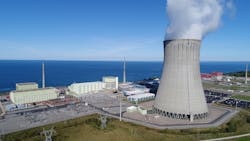New York Nuclear power fueling Green Hydrogen production by Constellation
A demonstration project at Constellation Energy’s Nine Mile Point nuclear power plant is now producing carbon-free green hydrogen for use in operations elsewhere at the facility.
The H2 production is created by electrolyzers powered by the nuclear power reactors at the Nine Mile Point site in Oswego, New York. Hydrogen is attractive for the energy transition because of its energy density and zero carbon makeup, but to be considered green it must be generated from electrolyzers powered by carbon-free resources such as wind, solar, hydro or nuclear.
Last year, the U.S. Department of Energy both approved the project and awarded $5.8 million to fund construction and installation of the Constellation Energy demonstration now up and running.
“This accomplishment tangibly demonstrates that our nation’s existing reactor fleet can produce clean hydrogen today,” said Dr. Kathryn Huff, assistant secretary for Nuclear Energy, DOE, “DOE is proud to support cost-shared projects like this to deliver affordable clean hydrogen. The investments we’re starting to make now through the Bipartisan Infrastructure Law and Inflation Reduction Act will even further expand the hydrogen market to create new economic and environmental benefits for nuclear energy.”
Hydrogen is seen as a major connection to keep both baseload, flexible power and decarbonization goals alive. It can be blended into gas-fired power turbines and also be a component of fuel-cell technologies which convert the gas into electricity to power vehicles.
Palo Verde Nuclear plant may power Hydrogen Shot project in Arizona
U.S., Ukraine plan collaboration on using Small Nuclear to generate Carbon-free H2 and Ammonia
Subscribe to EnergyTech's newsletter for Everyday Insights into the C&I Energy Transition
Hydrogen, the lightest gas, is not abundantly available and must be created by separating the H2 from methane gas (natural gas) via steam reforming or by electrolysis splitting the element from water.
“Hydrogen will be an indispensable tool in solving the climate crisis, and Nine Mile Point is going to show the world that nuclear power is the most efficient and cost-effective way to make it from a carbon-free resource,” said Joe Dominguez, president and CEO of Constellation. “In partnership with DOE and others, we see this technology creating a pathway to decarbonizing industries that remain heavily reliant on fossil fuels, while creating clean-energy jobs and strengthening domestic energy security.”
The Nine Mile Point project uses 1.25 MW of the nuclear power to produce 560 kilograms of green hydrogen per day. This amount is more than enough to meet the power plant’s operational needs for H2, although Constellation eventually hopes to scale up the technology for deployment at other sites.
The nation's nuclear power reactors account for nearly 20 percent of the U.S. electricity resource mix and more than half of the carbon-free power generated, according to federal statistics.
-- -- --
(Rod Walton, senior editor for EnergyTech, is a 15-year veteran of covering the energy industry both as a newspaper and trade journalist. He can be reached at [email protected]).
Follow us on Twitter @EnergyTechNews_ and @rodwaltonelp and on LinkedIn
About the Author
Rod Walton, EnergyTech Managing Editor
Managing Editor
For EnergyTech editorial inquiries, please contact Managing Editor Rod Walton at [email protected].
Rod Walton has spent 17 years covering the energy industry as a newspaper and trade journalist. He formerly was energy writer and business editor at the Tulsa World. Later, he spent six years covering the electricity power sector for Pennwell and Clarion Events. He joined Endeavor and EnergyTech in November 2021.
Walton earned his Bachelors degree in journalism from the University of Oklahoma. His career stops include the Moore American, Bartlesville Examiner-Enterprise, Wagoner Tribune and Tulsa World.
EnergyTech is focused on the mission critical and large-scale energy users and their sustainability and resiliency goals. These include the commercial and industrial sectors, as well as the military, universities, data centers and microgrids. The C&I sectors together account for close to 30 percent of greenhouse gas emissions in the U.S.
He was named Managing Editor for Microgrid Knowledge and EnergyTech starting July 1, 2023
Many large-scale energy users such as Fortune 500 companies, and mission-critical users such as military bases, universities, healthcare facilities, public safety and data centers, shifting their energy priorities to reach net-zero carbon goals within the coming decades. These include plans for renewable energy power purchase agreements, but also on-site resiliency projects such as microgrids, combined heat and power, rooftop solar, energy storage, digitalization and building efficiency upgrades.

